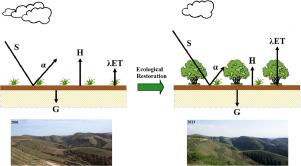Agricultural and Forest Meteorology ( IF 6.2 ) Pub Date : 2021-10-17 , DOI: 10.1016/j.agrformet.2021.108669 Fuxiao Jiang 1, 2 , Xianhong Xie 1, 2 , Shunlin Liang 3 , Yibing Wang 1, 2 , Bowen Zhu 1, 2 , Xiaotong Zhang 1, 2 , Yuchao Chen 1, 2

|
Evapotranspiration (ET) is a key variable coupled with water and energy availability and vegetation coverage. Since the year around 2000, several ecological restoration programs have been enacted within the Loess Plateau, China. The restoration programs have promoted vegetation greening and air cleaning, which has changed land surface albedo and solar radiation and consequently altered the land surface radiative forcing. Evidence has showed that ET is impacted by climate change and land use/cover change, but little is known about the effect of the radiative forcing on ET. This study reports the contribution of the surface radiative forcing during the growing season associated with ecological restoration to changes in potential ET (PET) and actual ET (AET) in the Loess Plateau. A differential attribution method based on the Penman-Monteith equation is proposed to isolate the contribution of radiative forcing. Accurate estimates of PET and AET are obtained from a sophisticated land surface hydrological model driven by long-term dynamic albedo, solar radiation, vegetation index, and meteorological forcings. We find that during 2003-2018, the surface albedo significantly decreased with increased solar radiation, which increased radiative forcing by 3.68 W m−2. These changes in radiative forcing increased PET and AET by 1.02 mm yr−1 and 0.12 mm yr−1, respectively. Despite spatial variabilities in radiative forcing, PET and AET intensified in approximately 50% (3.03 × 105 km2) and 60% (3.63 × 105 km2) of the area of the Loess Plateau, respectively. However, the PET and AET intensified by radiative forcing accounted for 8% and 5% of the total change in PET and AET, respectively. Although the average contribution of radiative forcing to the Loess Plateau is relatively small, the accumulated impact is non-negligible; it may mediate hydrological cycle and result in substantial water resource stress, particularly in areas implementing intensive ecological restoration.


























 京公网安备 11010802027423号
京公网安备 11010802027423号